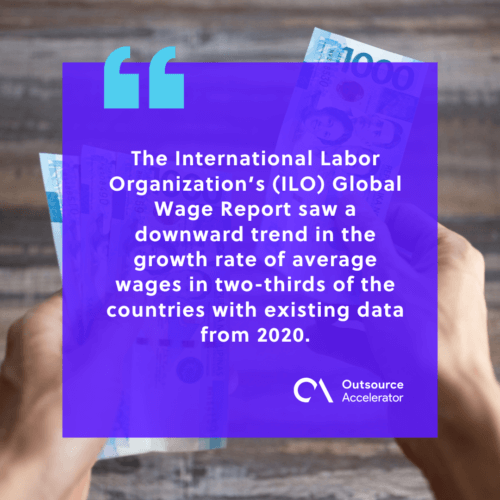Check out the average wages around the world in 2025

The global workforce continues to undergo changes driven by technological advancements, demographic shifts, and evolving economic conditions. One crucial aspect of this involves the move in wages around the world.
The average wage in a particular country impacts various economic indicators, such as inflation, consumption patterns, and government revenue. It also impacts how businesses of all sizes decide to run their operations, whether through outsourcing or keeping things in-house.
Everyone should closely examine the trends in average wages around the world to understand how the global economy is evolving. It can help identify potential opportunities and challenges for businesses, workers, and policymakers.
We will explore the average wages around the world in 2024 and the factors that affect them.
Factors affecting the average wage worldwide
Credentials, work experience, and industry are some of the factors affecting the average wage in general.

However, comparing the average wages on a larger scale is usually complicated since more factors impact how this differs and is calculated worldwide. This includes the following:
Cost of living
The cost of living in a particular country is usually matched to its average wage. Countries with low living costs usually have low wages.
However, there has been an existing mismatch between the two in most developing countries. In the Philippines, for instance, the think tank Ibon Foundation finds that the average wage in the country is far from the prescribed living standard in the country.
Geographical location
Research shows that location also affects the average wages through several factors, such as employment opportunities and quality of living.
This, in turn, also affects how individuals choose which place to live.[1] For instance, a person may select location A with a lower cost of living but good pay for nurses compared to location B with better wages, a higher cost of living, and low demand for their role.
Regional price parities
Migration is one of the aspects impacting regional price parities[2] in countries like the US. This is because families with higher income levels tend to move to the most expensive and constrained parts of the country.
Economic crises
Lastly, economic crises largely affect the average wages worldwide in terms of its growth, as proven by the pandemic.
The International Labor Organization’s (ILO) Global Wage Report saw a downward trend in the growth rate of average wages in two-thirds of the countries with existing data from 2020.

Average wages around the world in 2025
Using the statistics from ILO and Numbeo, we have listed the countries with the highest and lowest average wages around the world.
Each data is based on the US purchasing power parity (PPP) as listed in the statistics.
Top 10 countries with low average wages
| Country | Average wage (as of 2024) | Minimum wage (ILO) |
| Egypt | US$144.31 | US$244.00 |
| Pakistan | US$146.02 | US$117.00 |
| Nigeria | US$160.13 | US$179.00 |
| Venezuela | US$178.61 | – |
| Sri Lanka | US$183.25 | US$130.00 |
| Nepal | US$204.20 | US$127.00 |
| Bangladesh | US$255.65 | US$67.00 |
| Algeria | US$269.40 | US$140.00 |
| Libya | US$289.20 | US$322.00 |
| Colombia | US$298.20 | US$477.00 |
Top 10 countries with high average wages
| Country | Average wage (as of 2024) | Minimum wage (ILO) |
| Switzerland | US$6,096.19 | US$3,415.00 |
| Singapore | US$4,990.81 | – |
| Luxembourg | US$4,917.79 | US$2,305.00 |
| United States | US$4,917.79 | US$1,257.00 |
| Iceland | US$4,091.90 | US$2,342.00 |
| Qatar | US$3,909.06 | US$385.00 |
| Denmark | US$3,531.06 | – |
| United Arab Emirates | US$3,510.56 | – |
| Netherlands | US$3,456.90 | US$2,020.00 |
| Australia | US$3,427.02 | US$2,462.00 |
Average wage as a reason to offshore services
To keep up with the high cost of living, it’s natural that the average wages in developed countries are similarly high. This, in turn, creates downsides to startups setting up shop in their location with the limitations in budget and talent in their areas.
Offshoring is a viable option for businesses to hire their teams cost-efficiently. Thanks to the advancements and an increasingly connected world, they can tap the best staff and roles at the best price possible in offshoring destinations such as India and the Philippines.
This helps them manage their investments better by getting teams at a fraction of hiring local talents and reallocating their services into growing their businesses.
Article references:
[1] Which place to live. Roback, J. (1982). Wages, Rents, and the Quality of Life. Journal of Political Economy, 90(6), pp.1257–1278. doi:https://doi.org/10.1086/261120.
[2] Regional price parities. Ganong, P. and Shoag, D. (2017). Why has regional income convergence in the U.S. declined? Journal of Urban Economics, 102, pp.76–90. doi:https://doi.org/10.1016/j.jue.2017.07.002.







 Independent
Independent




